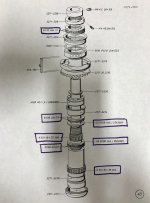Talking about Deckel mysteries
I talked to a guy yesterday that worked at ACEC in Gent Belgium that made Deckel FP1 2 and 3 there
He said their castings were much better as the german ones
This college talks about it too on his website
Over ons
Peter
Google translate from Dutch...
How are we actually started?
============================
The company machines Crispyn Founded in 1982, though Crispyn much longer involved with metalworking machines.
3 generations ago, my grandfather Adolphe Crispyn employed by ACEC firm in Ghent.
By ACEC they made when the legendary Deckel FP1 and FP3 models.
These were conventional milling machines to a quality not to emulate today. My grandfather was at least partly responsible for the casting of the Deckel parts.Deckel was a German manufacturer of milling machines which still exists under the name DMG Mori which now manufacture quality CNC machines."Parts were immediately remelted at least casting mistake that Germans were there incredibly strict on" I can still hear my grandfather tell.
Ghent had developed a special type of cast iron and Germany could not match the quality.
There is until today still exist Belgian Deckels which are known as the better Deckels.
The son of Adolphe, my father Wilfried had as a child bitten by mechanics.
On the kitchen table at home there were dozens of gears and shafts of the mechanical work of a clock.
"But now he will never hear more together" Adolphe's father said Wilfried.
Nothing was further from the truth, Wilfried dismantled and restored the toughest mechanical parts.
When Wilfried graduating as a metalworker he worked as a technician in various companies including many years with a machine dealer.
There was Wilfried risen to the specialist mechanical repairs on brands like Behringer, Eisele, Alzmetall, Peddinghaus name it.
Several times when Wilfried has been to producers and he has as his specialization evolved to what it is today.
In 1982 it was time to start their own business.
First single with the official car spot repairs and do something later Wilfried rented a shed.
With this pilot Wilfried was also well equipped to do complete overhauls of machines.
With a lathe, a milling machine and saw Wilfried could do all lot of work.




 )
)
